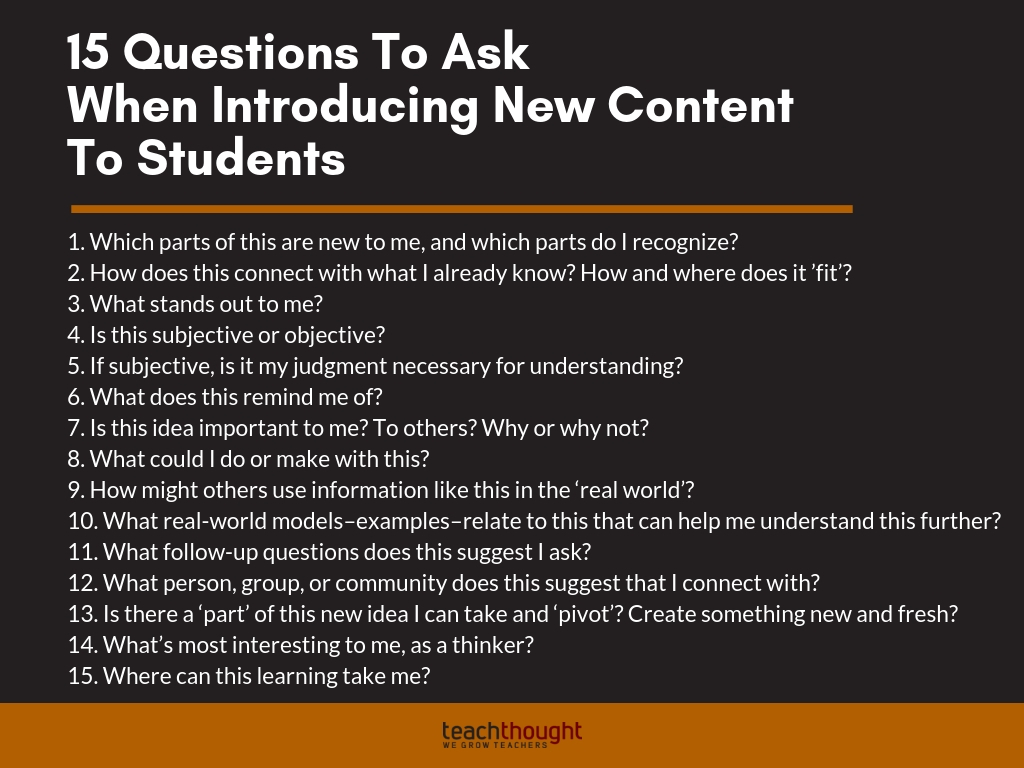
15 Questions To Ask When Introducing New Content To Students
by Terry Heick
It just might be that in a society where information is abundant, thinking habits are more important than knowledge.
Somewhere beneath wisdom and above the ‘things’ a student knows. Laws of economics say that scarcity increases value. It’s no longer information that’s scarce, but rather meaningful response to that information.
Thought.
And thought has a source–a complex set of processes, background knowledge, and schema that we can, as educators think of as cognitive habits. And if they’re habits, well, that means they’re probably something we can practice at, doesn’t it?
The Navigation Of Information
Even in the age of information, not every student has a smartphone; not every classroom has WiFi; not every home has tablets, or even dictionaries, magazines, and other “packaged data.”
We’ve talked about how teaching might adjust to the Google generation. To claim that the advent of Google makes knowledge–knowing–irrelevant is silly. The ubiquity of information can’t dissolve its value. It doesn’t stop being useful or changing or compelling because there’s a lot of it and its more accessible than at any time in human history.
But it does move knowledge around a bit on the bustling concept map of understanding–changes it in priority, and gives us a chance to see the learning process in a different way.
Instead of a teacher distributing information for students to absorb, many (most?) students can now access that information directly. This suggests, among other revelations, that the navigation of that knowledge is, to the student, more immediately useful than the knowledge itself. And that navigation, rather than being about strategies, is most immediately about habits. How do students respond when confronted with new ideas? Data, systems, patterns, concepts, and just maybe some degree of cognitive dissonance.
What does their mind literally do at that moment they see something new? That moment, like the inception of the universe itself, is what we need to slow down and try to understand. Neurology can help, but we can see it with our own eyes in the classroom. What do they do? What do you notice? And what have you done to create that response?
See also 23 Maker Learning Reflection Questions For Students
Questions To Ask As Metacognitive Practice
Metacognition isn’t a matter of a ‘lesson,’ or a teacher telling students it’s something they should do. Rather, it’s a matter of habit. Habits are everything. So, below are 15 questions to help students respond to new ideas, and begin to establish the kinds of habits that make thinkers, and just maybe, starting telling you what you want to hear.
Whether or not they truly become habits depends on how you use them. If you make them useful and familiar and meaningful, or alien, adult-sounding, and awkward. That’s on you as a teacher of your grade level and content area and school and community.
You might notice, though, the student-centered and purposefully-uncertain language used. Might. Suggest. Me. I. Could. Naturally. What stands out to me?
If you say, “What stands out?”, there’s an implication that there is something you’ve already noticed, as a teacher, and you want to know if they see it too. And if they do see it, they’re smart, and if not, they can continue to guess what you’re thinking. This not only decenters the student but the content as well, devolving the process into a distracting game of cat and mouse.
By saying “What stands out to you?”, you’re asking the student to internalize this ‘new idea’–a right angle, verbal irony, the speed of light, etc.–to stop short of ‘understanding’ and simply observe. Approach it carefully and playfully.
What do you see?
That’s it. When they have trouble responding even here, you’ll know that it’s not knowledge that’s the problem, but rather confidence, self-efficacy, and the thinking habits they fall back on when ‘put on the spot’ by a teacher.
One of the most powerful ways to learn is practice. Giving students the opportunity to learn not information, but reflective and reflexive habits that help create learners. Thinkers. Students not only capable of thinking for themselves but prone to do so as a matter of habit.
As a teacher, on a daily basis you’re exposing students to new ideas–or existing ideas in new ways. How are you supporting them in these cognitive disruptive events? How are you teaching them to think?
15 Questions To Ask When Introducing New Content To Students
1. Which parts of this are new to me, and which parts do I recognize?
2. How does this connect with what I already know? How and where does it ’fit’?
3. What stands out to me?
4. Is this subjective or objective?
5. If subjective, is it my judgment necessary for understanding?
6. What does this remind me of?
7. Is this idea important to me? To others? Why or why not?
8. What could I do or make with this?
9. How might others use information like this in the ‘real world’?
10. What real-world models–examples–relate to this that can help me understand this further?
11. What follow-up questions does this suggest I ask?
12. What person, group, or community does this suggest that I connect with?
13. Is there a ‘part’ of this new idea I can take and ‘pivot’? Create something new and fresh?
14. What’s most interesting to me, as a thinker?
15. Where can this learning take me?
15 Questions To Ask That Can Help Student Make Sense Of New Ideas